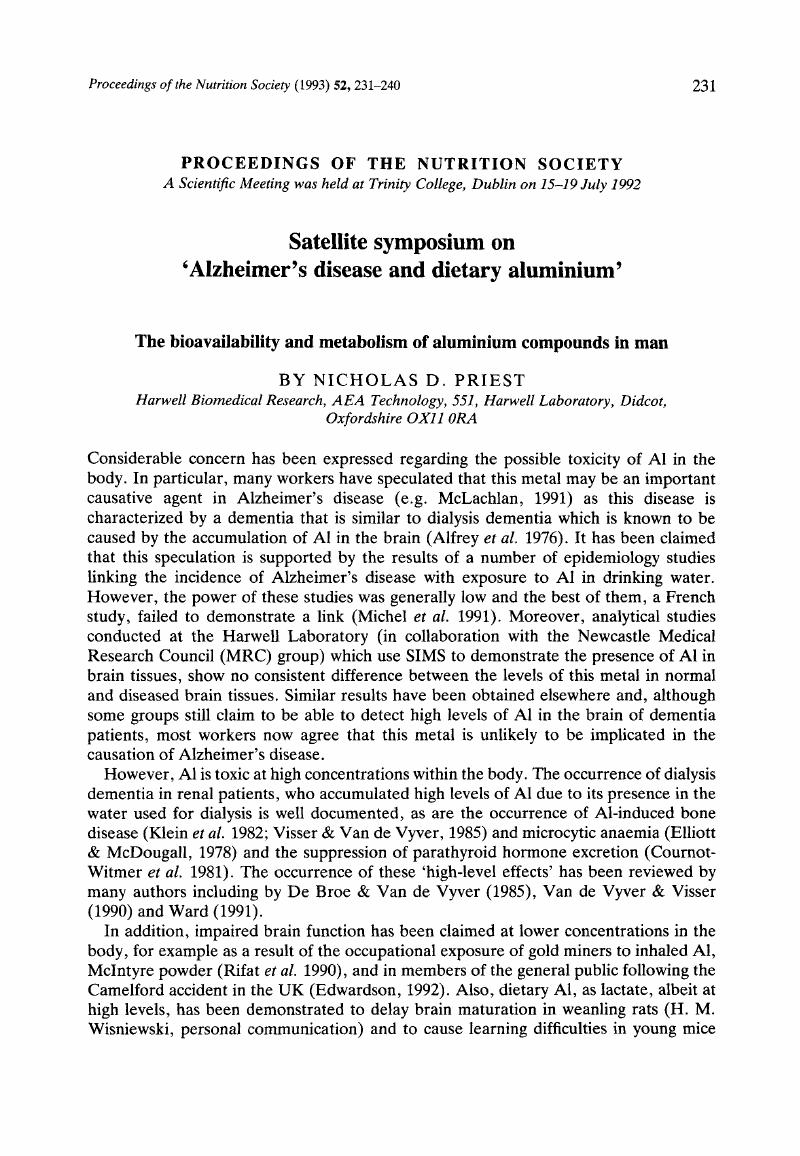Crossref Citations
This article has been cited by the following publications. This list is generated based on data provided by Crossref.
Yao, Xiu‐Lan
Jenkins, Edmund C.
and
Wisniewski, Henryk M.
1994.
Effect of aluminum chloride on mitogenesis, mitosis, and cell cycle in human short‐term whole blood cultures: Lower concentrations enhance mitosis.
Journal of Cellular Biochemistry,
Vol. 54,
Issue. 4,
p.
473.
Priest, N. D.
Talbot, R. J.
Austin, J. G.
Day, J. P.
King, S. J.
Fifield, K.
and
Cresswell, R. G.
1996.
The bioavailability of26Al-labelled aluminium citrate and aluminium hydroxide in volunteers.
BioMetals,
Vol. 9,
Issue. 3,
p.
221.
Borak, Jonathan
and
Wise, John Pierce
1998.
Does aluminum exposure of pregnant animals lead to accumulation in mothers or their offspring?.
Teratology,
Vol. 57,
Issue. 3,
p.
127.
Stauber, Jennifer L.
Florence, T. Mark
Davies, Cheryl M.
Adams, Merrin S.
and
Buchanan, S. John
1999.
Bioavailability of Al in alum‐treated drinking water.
Journal AWWA,
Vol. 91,
Issue. 11,
p.
84.
Soni, Madhusudan G.
White, Susan M.
Flamm, W.Gary
and
Burdock, George A.
2001.
Safety Evaluation of Dietary Aluminum.
Regulatory Toxicology and Pharmacology,
Vol. 33,
Issue. 1,
p.
66.
Dinman, Bertram D.
2001.
Patty's Toxicology.
2002.
Metal Contamination of Food.
p.
115.
Li, Liang
2003.
The Biochemistry and Physiology of Metallic Fluoride: Action, Mechanism, and Implications.
Critical Reviews in Oral Biology & Medicine,
Vol. 14,
Issue. 2,
p.
100.
Priest, N. D.
2004.
The biological behaviour and bioavailability of aluminium in man, with special reference to studies employing aluminium-26 as a tracer: review and study update.
J. Environ. Monit.,
Vol. 6,
Issue. 5,
p.
375.
Saiyed, Salim M.
and
Yokel, Robert A.
2005.
Aluminium content of some foods and food products in the USA, with aluminium food additives.
Food Additives and Contaminants,
Vol. 22,
Issue. 3,
p.
234.
Priest, N.D.
2005.
Encyclopedia of Human Nutrition.
p.
69.
Yokel, Robert A.
and
Florence, Rebecca L.
2006.
Aluminum bioavailability from the approved food additive leavening agent acidic sodium aluminum phosphate, incorporated into a baked good, is lower than from water.
Toxicology,
Vol. 227,
Issue. 1-2,
p.
86.
Krewski, Daniel
Yokel, Robert A
Nieboer, Evert
Borchelt, David
Cohen, Joshua
Harry, Jean
Kacew, Sam
Lindsay, Joan
Mahfouz, Amal M
and
Rondeau, Virginie
2007.
Human Health Risk Assessment for Aluminium, Aluminium Oxide, and Aluminium Hydroxide.
Journal of Toxicology and Environmental Health, Part B,
Vol. 10,
Issue. sup1,
p.
1.
Yokel, Robert A.
Hicks, Clair L.
and
Florence, Rebecca L.
2008.
Aluminum bioavailability from basic sodium aluminum phosphate, an approved food additive emulsifying agent, incorporated in cheese.
Food and Chemical Toxicology,
Vol. 46,
Issue. 6,
p.
2261.
Seng Yue, Corinne
Christie, Megan
Lavergne, Valery
Sikaneta, Tabo
Taskapan, Hulya
Mardini, Karine
Tam, Paul
Ting, Robert
and
Ghannoum, Marc
2011.
Aluminum toxicokinetics in peritoneal dialysis patients.
Clinical Toxicology,
Vol. 49,
Issue. 7,
p.
659.
Stanek III, Edward J.
Calabrese, Edward J.
and
Xu, Bo
2012.
Meta‐Analysis of Mass‐Balance Studies of Soil Ingestion in Children.
Risk Analysis,
Vol. 32,
Issue. 3,
p.
433.
Kepp, Kasper P.
2012.
Bioinorganic Chemistry of Alzheimer’s Disease.
Chemical Reviews,
Vol. 112,
Issue. 10,
p.
5193.
Shaw, Christopher A
Li, Dan
and
Tomljenovic, Lucija
2014.
Are there Negative CNS Impacts of Aluminum Adjuvants Used in Vaccines and Immunotherapy?.
Immunotherapy,
Vol. 6,
Issue. 10,
p.
1055.
Stephens, Brian R.
and
Jolliff, James S.
2015.
Diet and Nutrition in Dementia and Cognitive Decline.
p.
553.
Sjögren, Bengt
Iregren, Anders
Montelius, Johan
and
Yokel, Robert A.
2015.
Handbook on the Toxicology of Metals.
p.
549.



